La belleza de lo escrito a mano: una charla con Gema de Caligrafía Artística
May 12, 2025
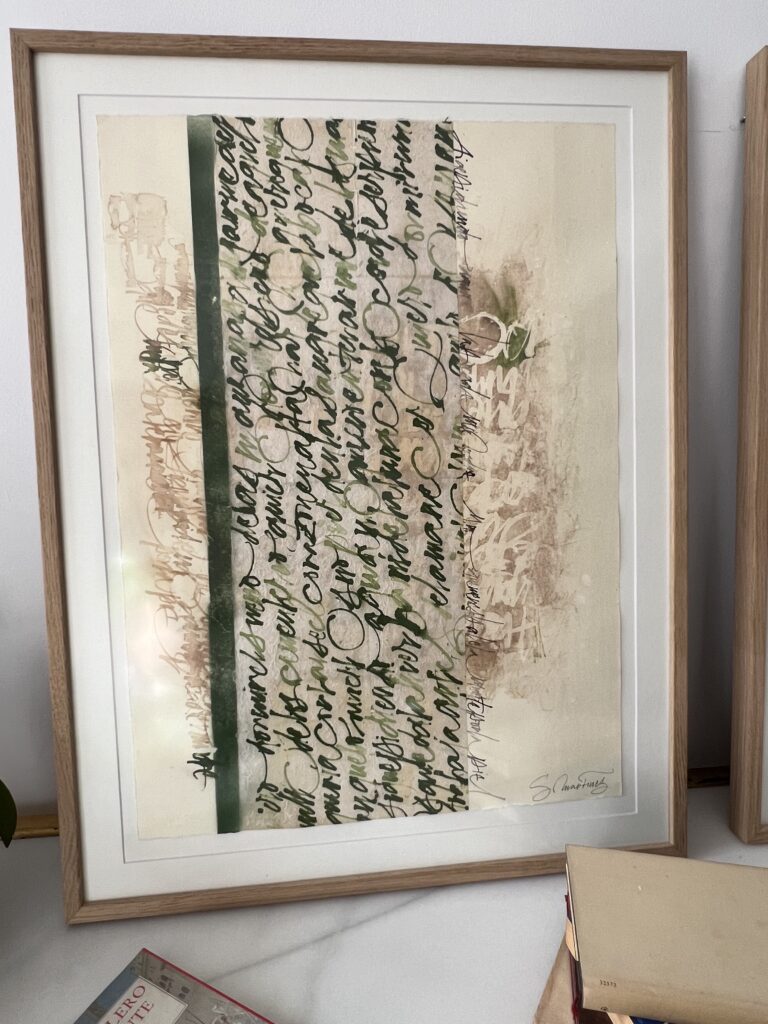
English translation at the end of this post*
A veces, te encuentras con un trabajo que no solo te hace detenerte al mirarlo, sino también a sentirlo. Eso me pasó la primera vez que vi el trabajo de Gema de Caligrafía Artística. Sus letras tienen un ritmo sereno, un cuidado visible, una calidez que traspasa la pantalla.
Llevo años siguiendo su trabajo por instagram, y aunque todavía no hemos tenido la oportunidad de colaborar (¡ojalá algún día!), he sido admiradora de su arte desde lejos. La caligrafía de Gema no es solo impresionante: tiene presencia, alma y ese algo especial que transforma hasta el detalle más pequeño en algo inolvidable. Con la ilusión de conocer más sobre su proceso creativo, le escribí, y con mucha generosidad, Gema respondió a mis preguntas. Estoy emocionada de poder compartir con vosotros su visión y su arte.
¿Cómo comenzó tu historia con la caligrafía?
De forma absolutamente casual y en un momento en el que me encontraba muy perdida. Había abandonado el periodismo, que fue mi profesión durante casi 20 años. La empresa que monté después no funcionó y me había tomado un tiempo de descanso. Fue entonces cuando una persona cercana me habló de la caligrafía para eventos. De eso hace ya casi 15 años. Yo no sabía absolutamente nada de la materia; ni siquiera que podía aprenderse. Me habló de un curso en Madrid y no lo dudé. A partir de ahí se convirtió en pasión y obsesión.
¿Qué inspira tu estilo y tu proceso creativo?
Experimento con la abstracción caligráfica. Libero a la escritura a mano de su función de ser leída; es decir, evito el rol por el que es conocida en occidente: su funcionalidad. Al sustraer la legibilidad, se manifiestan otros aspectos que habían quedado ocultos, como el ritmo, las formas, el gesto y la conexión interna; la introspección que sucede en al acto de escribir; el momento exacto en el que la mano escribe. En mi proceso creativo atiendo especialmente a la pulsión interna; a esa tensión que se libera creando.
¿Tienes algún ritual o costumbre antes de ponerte a crear?
No, al menos conscientemente. Sí hay un periodo de incubación; algo que bulle por dentro; como una inquietud. Lo contengo hasta que no puedo más y entonces surge la necesidad de hacer algo, lo que sea. Ahí comienzan las posibilidades. Suelo sorprenderme del resultado y siempre pienso que se había gestado antes, dentro. Luego, durante el proceso de crear sí suelo dar vueltas alrededor de la mesa, mirando la pieza. Es así como llega el siguiente paso. Solvitur ambulando, que diría San Agustín.
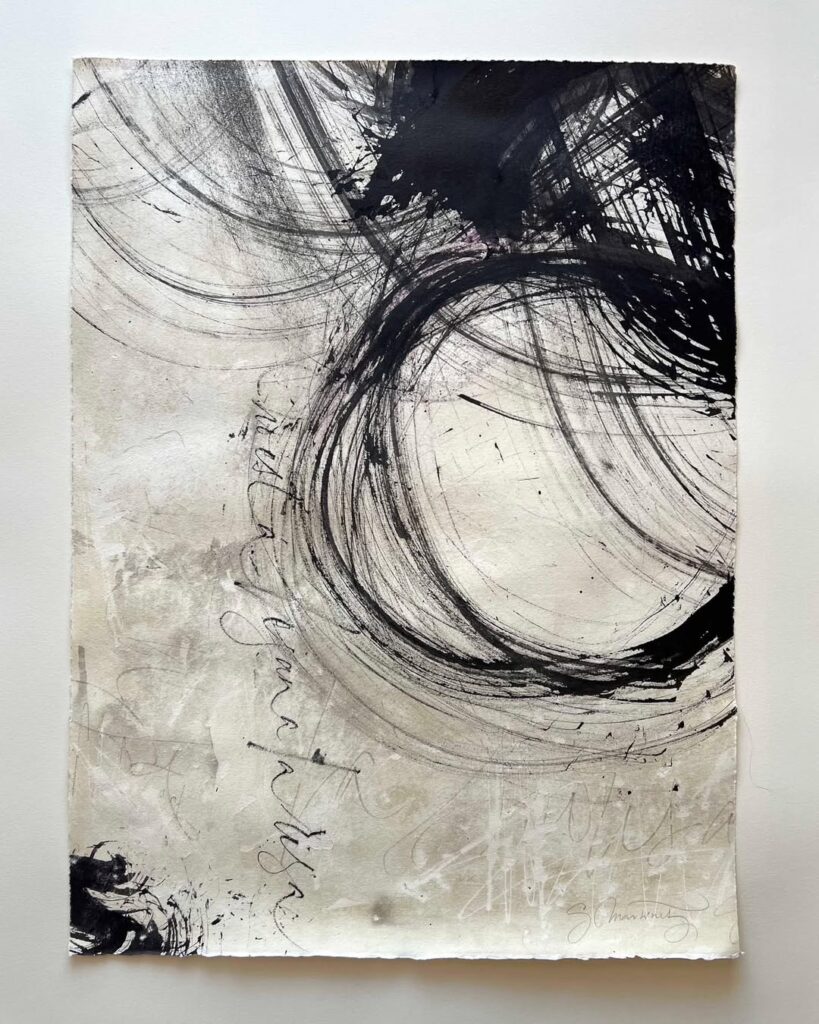
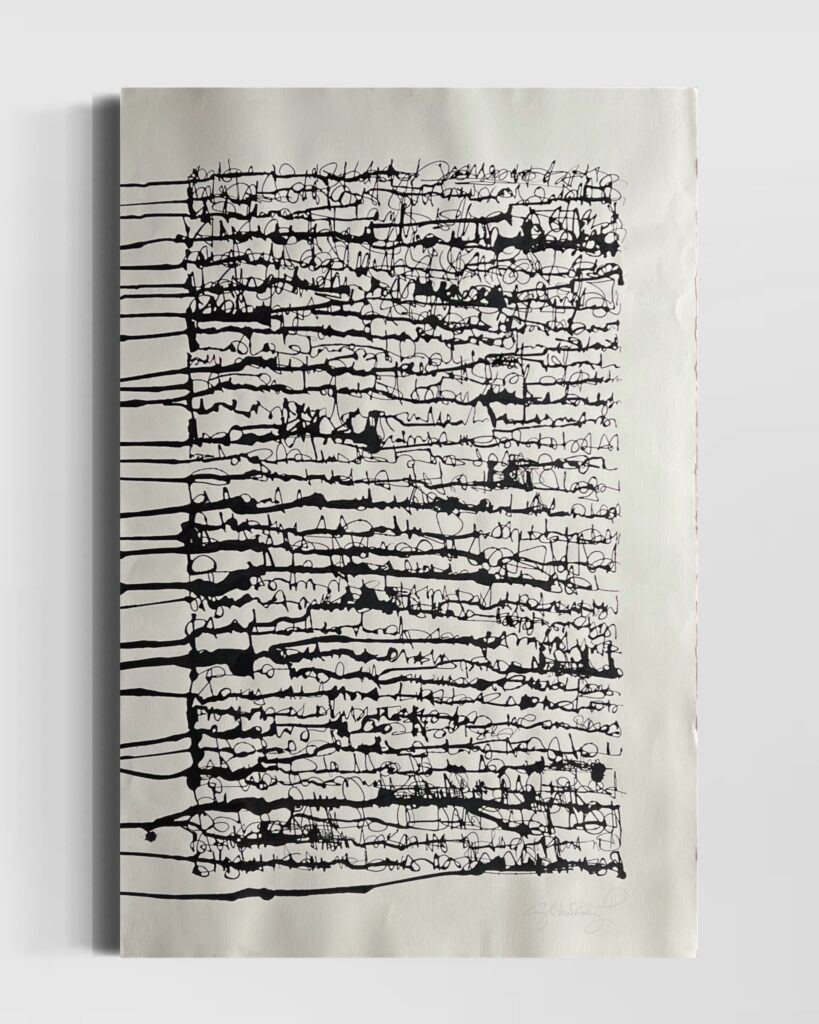
¿Cómo describirías la esencia de tu trabajo en pocas palabras?
Visceral, intuitivo y, a veces, un poco salvaje :))
¿Qué es lo que más disfrutas de ser calígrafa?
En estos momentos, lo que más disfruto, es la exploración. Me asombra todo el potencial expresivo de la escritura a mano, sus posibilidades estéticas. Me parece alucinante que la escritura a mano, a la que daban por muerta, pueda reinventarse y transformarse en arte.
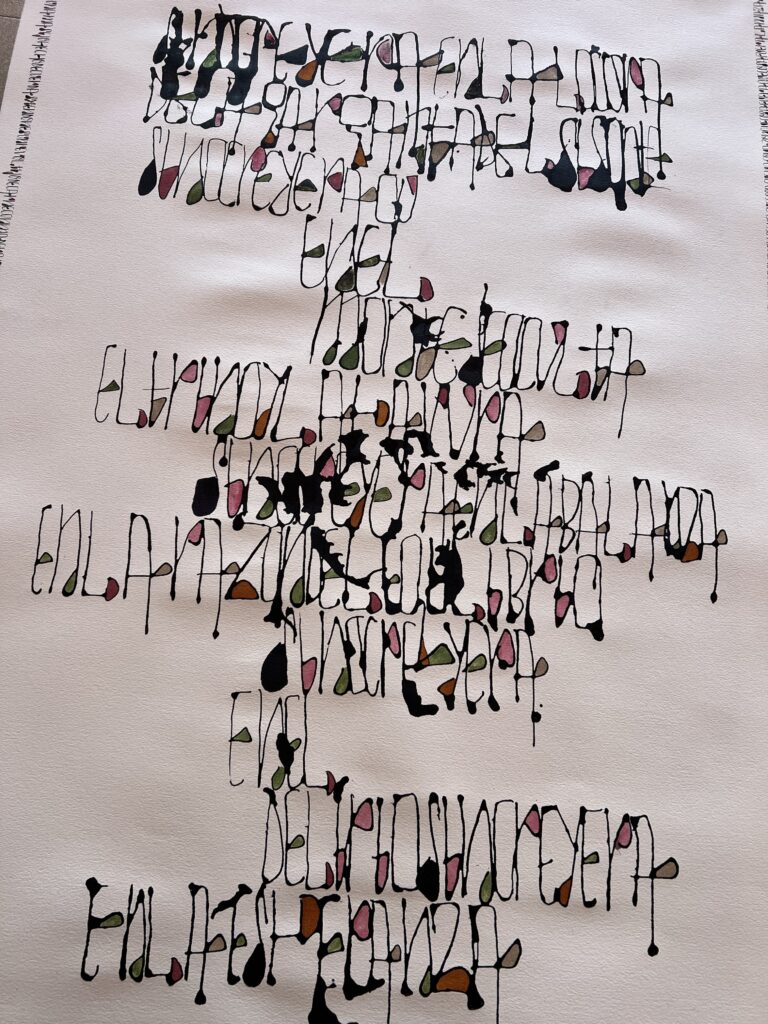
¿Cuál ha sido uno de los mayores retos que has vivido en tu camino creativo?
Darme permiso para crear. Permitirme ser artista. Seguir y seguir. Pensar en tirar la toalla y no hacerlo. Superar el miedo a la exposición. Yo creo que los mayores retos siempre son mentales.
¿Hay algún proyecto o colaboración soñada que tengas en mente?
Me encantaría hacer una gran exposición; muy inmersiva, en la que los trazos, el ritmo de la escritura a mano, las texturas llenaran todo el espacio. Si pudiera pedir una colaboración soñada, en estos momentos sería con Mariem Abutaleb, una joven calígrafa egipcia que me maravilla. Trabaja la repetición de las grafías y la modificación de los signos y sus composiciones son hipnóticas.
¿Qué crees que suele malinterpretarse sobre la caligrafía?
Que tiene que ver con nuestra propia letra. La caligrafía se aprende. Hay técnicas. Mi letra “real” es letra de periodista que escribía a toda prisa en posiciones imposibles. La caligrafía, como arte, se aprende. Mi letra de calígrafa nada tiene que ver con mi letra de andar por casa. Otra confusión que se da con cierta frecuencia es pensar que somos peritos calígrafos; es decir, que analizamos la escritura de los demás.
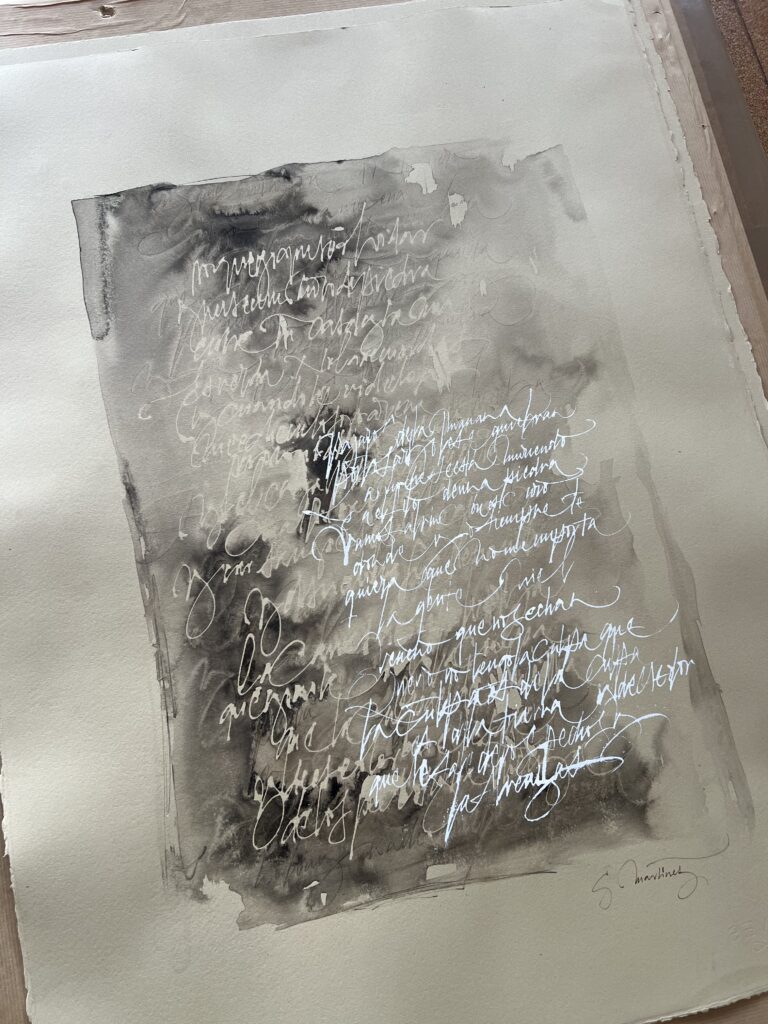
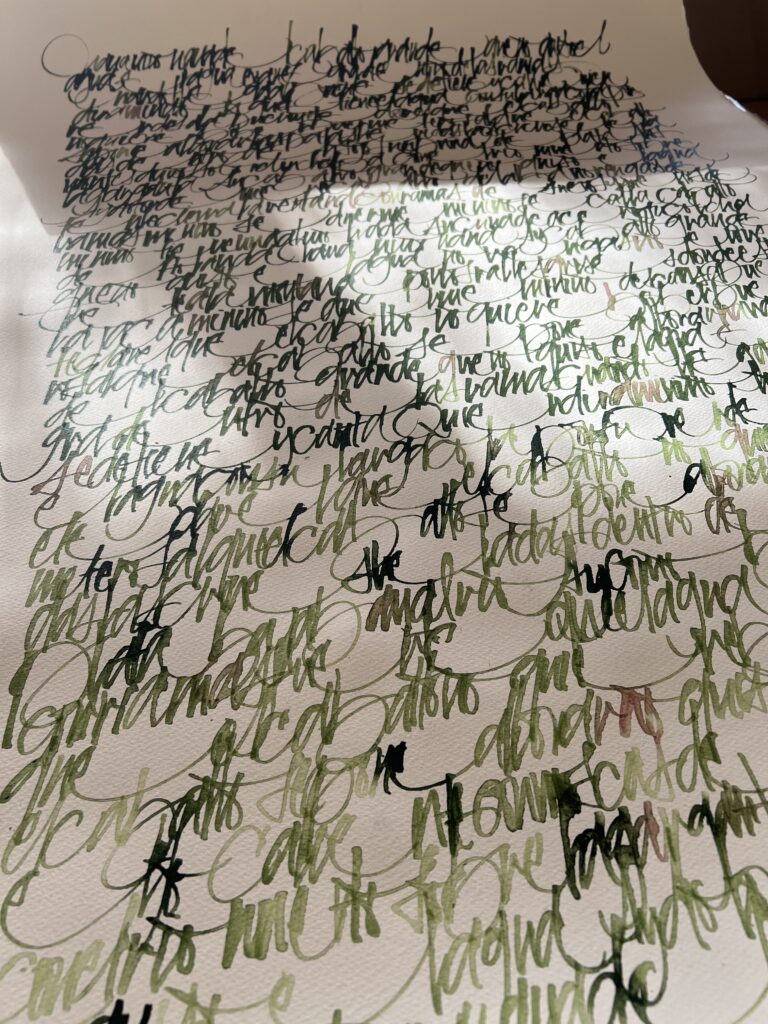
¿Qué te gustaría que la gente sintiera al ver tu trabajo?
Emoción
¿Qué consejo le darías a alguien que quiere empezar en el mundo de la caligrafía?
Que empiece, que lo haga. Que pruebe y también que se arme de paciencia, aunque si le apasiona, la paciencia se va a dar porque la va a nutrir la obsesión por la escritura. Por supuesto, que busque maestros de verdad; con trayectoria. Que invierta en buenas formaciones.
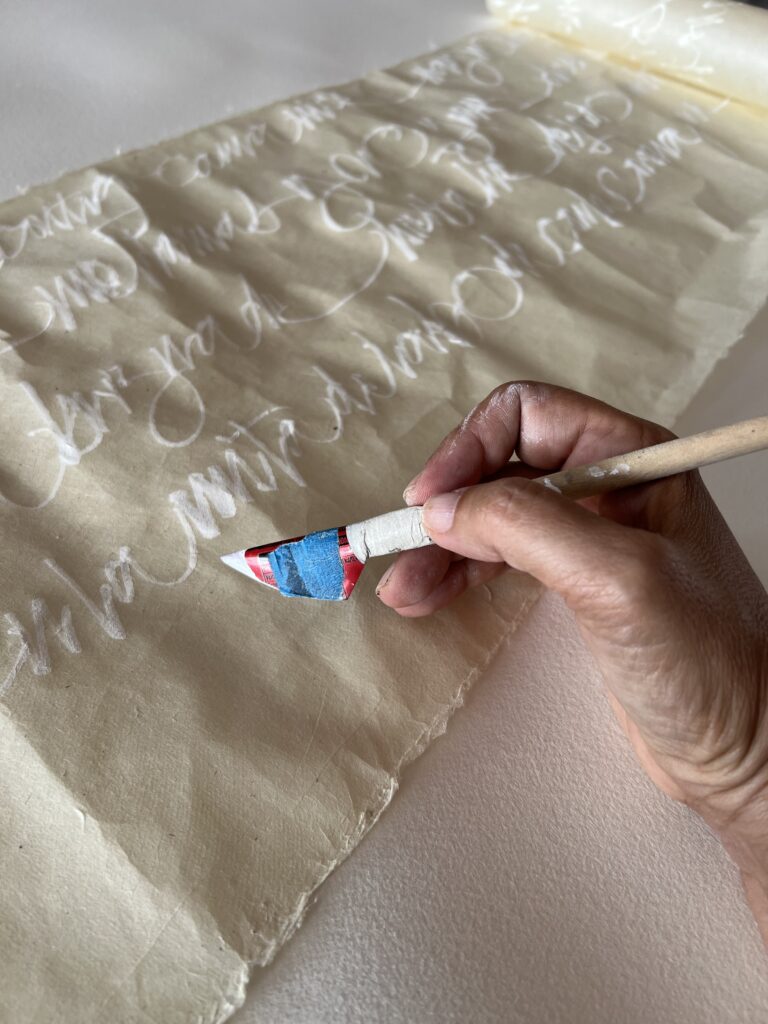
Es difícil poner en palabras la forma en que el trabajo de Gema te llega, pero lo intentaré: el arte tiene el poder de movernos, de dejarnos una huella. Y Gema, con su caligrafía, lo hace. Le dije hace tiempo que, en cuanto regrese a casa, será la primera persona a la que le encargue una pieza personalizada, y créanme, lo digo en serio. Porque el arte de Gema no solo es bello, es el tipo de belleza que te deja sin palabras, que te habla directamente al corazón.
Espero que, al leer sus respuestas, todos puedan conocer un poco más de la magia que hay detrás de sus trazos y, quién sabe, tal vez también se sientan inspirados por su arte tanto como yo.
Podéis encontrar a Gema y su trabajo en @caligrafia_artistica.
Gracias, Gema, por permitirnos asomarnos a tu mundo <3
The Beauty of Handwritten Art: A Chat with Gema of Caligrafía Artística
Sometimes, you come across a piece of work that doesn’t just make you stop to look at it, but also to feel it. That’s what happened the first time I saw Gema’s work from Caligrafía Artística. Her letters have a serene rhythm, a visible care, a warmth that goes beyond the screen.
I’ve been following her work on instagram for years, and although we haven’t had the chance to collaborate yet (hopefully soon!), I’ve been an avid admirer of art from afar. Gema’s calligraphy is not just beautiful: it has presence, soul, and that special something that transforms even the smallest detail into something unforgettable. With the excitement of learning more about her creative process, I wrote to her, and with great generosity, Gema responded to my questions. I’m thrilled to share with you all her vision and her art.
How did your story with calligraphy begin?
Completely by chance, and at a time when I felt very lost. I had left journalism, which had been my profession for almost 20 years. The business I started afterward didn’t work out, and I had taken some time off. That’s when someone close to me told me about calligraphy for events. That was nearly 15 years ago now. I knew absolutely nothing about it, not even that it could be learned. They told me about a course in Madrid, and I didn’t hesitate. From that moment on, it became a passion and an obsession.
What inspires your style and creative process?
I experiment with calligraphic abstraction. I free handwriting from its purpose of being read, meaning I avoid the role it’s traditionally known for in the West, which is function. When legibility is removed, other elements begin to emerge, like rhythm, form, gesture, and a sense of internal connection. There’s introspection that happens in the act of writing, in the exact moment when the hand moves across the page. In my creative process, I pay special attention to that internal drive, to the tension that gets released through creating.
Do you have any rituals or habits before you start creating?
Not consciously, at least. There’s usually a kind of incubation period, something stirring inside, a restlessness. I hold onto it until I can’t anymore, and then comes the need to make something, anything. That’s when the possibilities open up. I’m often surprised by the result and feel like it had already been forming inside me. During the process, I usually walk around the table, observing the piece. That’s how the next step comes to me. Solvitur ambulando, as Saint Augustine would say.
How would you describe the essence of your work in a few words?
Visceral, intuitive, and sometimes a little wild.
What do you enjoy most about being a calligrapher?
Right now, what I enjoy the most is exploration. I’m amazed by the expressive potential of handwriting and all its aesthetic possibilities. I find it incredible that handwriting, once considered outdated, can reinvent itself and become art.
What has been one of the biggest challenges you’ve faced in your creative journey?
Giving myself permission to create. Allowing myself to be an artist. To keep going. To think about quitting and not do it. Overcoming the fear of being seen. I think the biggest challenges are always mental.
Is there any dream project or collaboration you have in mind?
I’d love to do a large, immersive exhibition where the strokes, the rhythm of handwriting, and the textures fill the entire space. If I could choose a dream collaboration, right now it would be with Mariem Abutaleb, a young Egyptian calligrapher who amazes me. She works with repetition of letterforms and modification of signs, and her compositions are hypnotic.
What do you think is often misunderstood about calligraphy?
That it’s just your natural handwriting. Calligraphy is something you learn. There are techniques behind it. My “real” handwriting is what you’d expect from a journalist writing in a rush under awkward conditions. The calligraphy I create as an artist is something entirely different. Another common misunderstanding is that people think we’re handwriting analysts, the kind that studies someone else’s writing for clues.
What would you like people to feel when they see your work?
Emotion.
What advice would you give to someone who wants to start in the world of calligraphy?
Start. Just do it. Give it a try, and be patient with yourself. If you’re passionate about it, patience will come naturally because it will be fueled by your love of writing. And of course, seek out real teachers, people with experience and a strong background. Invest in solid training.
It’s hard to put into words the way Gema’s work touches you, but I’ll attempt it: art has the power to move us, to leave a mark. And Gema, with her calligraphy, does just that. I told her long ago that as soon as I return home, she’ll be the first person I order a custom piece from, and believe me, I mean it. Because Gema’s art is not only beautiful, it’s the kind of beauty that leaves you speechless, that speaks directly to your heart.
I hope that, by reading her responses, everyone can get to know a little more about the magic behind her brush strokes and, who knows, maybe they’ll feel as inspired by her art as I do.
You can find Gema and her work at @caligrafia_artistica.
Thank you, Gema, for allowing us a glimpse into your world.
Leave a Reply Cancel reply
©2024 BODEGA PRESS - ALL RIGHTS RESERVED
a luxury modern letterpress wedding invitation studio dedicated to conveying beauty discernible not just to the eye, but to the touch.
info
let’s connect
stay in the know of our latest news, tips and offers
back to top
Custom Letterpress Wedding Invitations & Heirloom Stationery. Modern & Colorful letterpress wedding invitations, save the dates and event stationery. Wedding stationery designed and printed by hand in our luxury design and letterpress studio.
Located between Brasilia and Dulles, Virginia. Services offered worldwide.
follow our journey on instagram
LINKED IN
Que bella entrevista. Gracias por mostrar una artista tan diferente y especial, con una obra increíble.
Gracias a ti por leerla. Me alegra muchísimo que te haya llegado así. Gema realmente tiene una sensibilidad única y fue un privilegio poder compartir un pedacito de su mundo.